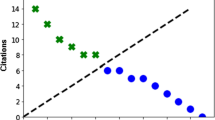Abstract
This paper proposes h l -index as an improvement of the h-index, a popular measurement for the research quality of academic researchers. Although the h-index integrates the number of publications and the academic impact of each publication to evaluate the productivity of a researcher, it assumes that all papers that cite an academic article contribute equally to the academic impact of this article. This assumption, of course, could not be true in most times. The citation from a well-cited paper certainly brings more attention to the article than the citation from a paper that people do not pay attention to. It therefore becomes important to integrate the impact of papers that cite a researcher’s work into the evaluation of the productivity of the researcher. Constructing a citation network among academic papers, this paper therefore proposes h l -index that integrating the h-index with the concept of lobby index, a measures that has been used to evaluate the impact of a node in a complex network based on the impact of other nodes that the focal node has direct link with. This paper also explores the characteristics of the proposed h l -index by comparing it with citations, h-index and its variant g-index.



Similar content being viewed by others
References
Alonso, S., Cabrerizo, F. J., Herrera-Viedma, E., & Herrera, F. (2009). H-index: A review focused in its variants, computation and standardization for different scientific fields. Journal of Informetrics, 3(4), 273–289.
Alonso, S., Cabrerizo, F. J., Herrera-Viedma, E., & Herrera, F. (2010). H g -index: A new index to characterize the scientific output of researchers based on the h- and g-indices. Scientometrics, 82(2), 391–400.
Barabási, A. L., & Albert, R. (1999). Emergence of scaling in random networks. Science, 5439(286), 509–512.
Barcza, K., & Telcs, A. (2009). Paretian publication patterns imply paretian hirsch index. Scientometrics, 81(2), 513–519.
Batista, P. D., Campiteli, M. G., & Kinouchi, O. (2006). Is it possible to compare researchers with different scientific interests? Scientometrics, 68(1), 179–189.
Bonacich, P. (1972). Factoring and weighting approaches to status scores and clique identification. Journal of Mathematical Sociology, 2(1), 113–120.
Bornmann, L., & Daniel, H. D. (2007). What do we know about the h index? Journal of the American Society for Information Science and Technology, 58(9), 1381–1385. doi:10.1002/asi.20609.
Bornmann, L., Mutz, R., & Daniel, H. D. (2008). Are there better indices for evaluation purposes than the h-index? A comparison of nine different variants of the h-index using data from biomedicine. Journal of the American Society for Information Science and Technology, 59(5), 830–837.
Egghe, L. (2006). Theory and practise of the g-index. Scientometrics, 69(1), 131–152.
Egghe, L. (2010). Influence of adding or deleting items and sources on the H-index. Journal of the American Society for Information Science and Technology, 61(2), 370–373. doi:10.1002/asi.21239.
Egghe, L., & Rousseau, R. (2006). An informetric model for the Hirsch-index. Scientometrics, 69(1), 121–129.
Glänzel, W. (2006). On the h-index—A mathematical approach to a new measure of publication activity and citation impact. Scientometrics, 67(2), 315–321.
Hirsch, J. E. (2005). An index to quantify an individual’s scientific research output. Proceedings of the National Academy of Sciences of America, 102(46), 16569–16572.
Jin, B. H. (2007). The AR-index: Complementing the h-index. ISSI Newsletter, 3(1), 6.
Jin, B. H., Liang, L. M., Rousseau, R., & Egghe, L. (2007). The R and AR indices: Complementing the h-index. Chinese Science Bulletin, 52(6), 855–863.
Katz, L. (1953). A new status index derived from sociometric analysis. Psychomatrika, 18(1), 39–43.
Kelly, C. D., & Jennions, M. D. (2006). The h index and career assessment by numbers. Trends in Ecology & Evolution, 21(4), 167–170.
Korn, A., Schubert, A., & Telcs, A. (2009). Lobby index in networks. Physica A, 388(11), 2221–2226.
Kosmulski, M. (2006). A new Hirsch-type index saves time and works equally well as the original h-index. ISSI Newsletter, 2(3), 4–6.
Liu, Y. X., & Rousseau, R. (2008). Properties of Hirsch-type indices: The case of library classification categories. Scientometrics, 79(2), 235–248.
Rousseau, R., & Jin, B. H. (2008). The age-dependent h-type AR(2)-index: Basic properties and a case study. Journal of the American Society for Information Science and Technology, 59(14), 2305–2311. doi:10.1002/asi.20928.
Schubert, A., & Glänzel, W. (2007). A systematic analysis of Hirsch-type indices for journals. Journal of Informetrics, 1(3), 179–184.
Yan, X. B., Zhai, L., & Fan, W. G. (2013). C-index: A weighted network node centrality measure for collaboration competence. Journal of Informetrics, 7(1), 223–239. doi:10.1016/j.joi.2012.11.004.
Ye, F. Y. (2011). A unification of three models for the h-index. Journal of the American Society for Information Science and Technology, 62(1), 205–207.
Yuan, J. P. (2010). Scientometrics advanced course. Shanghai: Science and Technology Literature Press of China.
Acknowledgments
This work is partly supported by the National Natural Science Foundation of PRC (Nos. 71171067, 70890082) and Postdoctoral Science-research Developmental Foundation of Heilongjiang province (No. LBH-Q11114).
Author information
Authors and Affiliations
Corresponding author
Rights and permissions
About this article
Cite this article
Zhai, L., Yan, X. & Zhu, B. The H l -index: improvement of H-index based on quality of citing papers. Scientometrics 98, 1021–1031 (2014). https://doi.org/10.1007/s11192-013-1039-z
Received:
Published:
Issue Date:
DOI: https://doi.org/10.1007/s11192-013-1039-z




